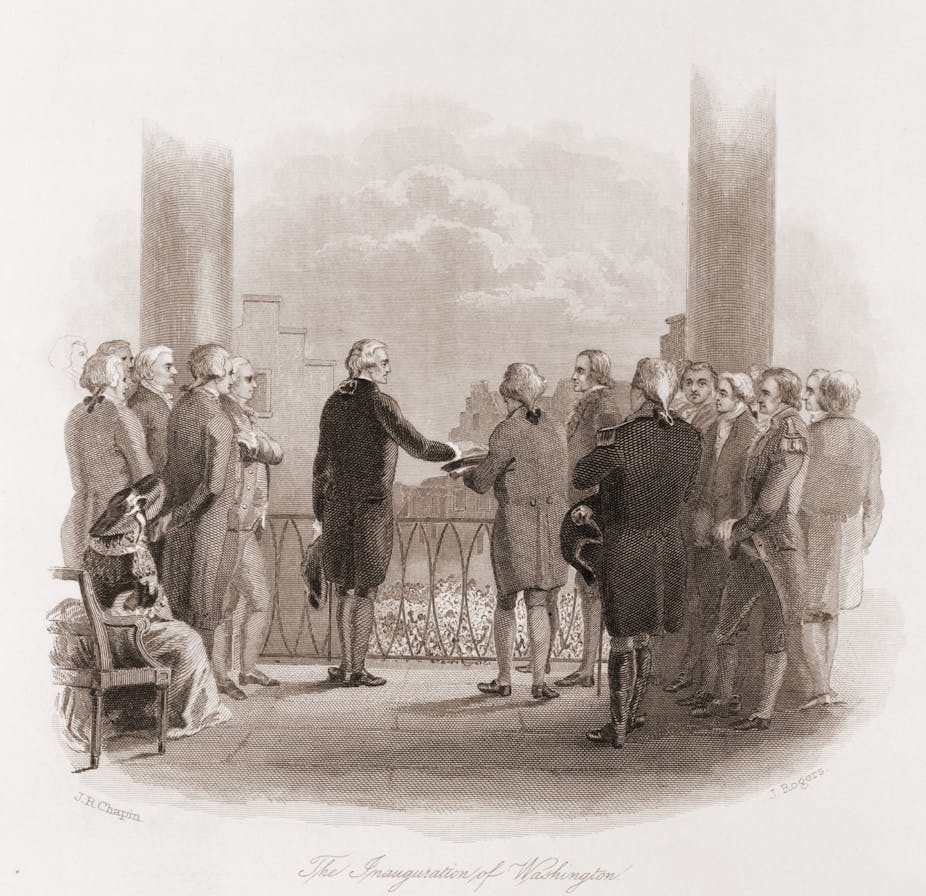No celebrities were booked for the US’s first ever presidential inauguration, but then again, they were hardly needed. There could be no greater celebrity than the man coming to town to be sworn in as the country’s first president.
On April 30, 1789, on the balcony of Federal Hall on New York City’s Wall Street, George Washington took the oath to faithfully execute the office of president and to “preserve, protect and defend the Constitution”. And now, after more than two centuries of American history, he has a 43rd successor in Donald Trump.
The first and 45th presidents are as unalike as any two men could be. Where Washington was always correct and reserved, Trump thrives on flouting convention; Washington’s studied self-deprecation stands in stark contrast to Trump’s puerile braggadocio. (It’s safe to say Washington would never have used Twitter.) Yet there are certain parallels in their ascendancy to the presidency.
If many pundits today believe that the US is in terminal decline, so in 1789 many Americans and most Europeans doubted that the American experiment in republican government would last. The widespread enthusiasm that the Declaration of Independence and struggle against King George had generated on both sides of the Atlantic only a decade before was all gone. “In a sense, both Washington and Trump were elected in the hope that they could make America great again”.
Divided we fall
More than most incoming presidents, Washington was entitled to ask “what the hell was going on”, in Trump’s colourful language. The War for Independence had thrown the US into a deep depression, and created a monumental national debt that went unpaid. The world’s major economies were shutting their markets against American products and American services.
In the continental interior, the border existed only on inaccurate maps. European American settlers squatted on American Indian land and on occasion the Indians retaliated, sparking headlines about murders and abductions in eastern papers and secessionist sentiment in western hearts. In faraway North Africa, the Muslim Barbary states held American sailors and citizens as slaves for ransom.
Washington had to deal with these and other problems with no army, no navy, no money and no credit. Where modern-day presidential hopefuls curry favour with the electorate by thumping a bloated federal bureaucracy, Washington’s problem was the reverse: there was no bureaucracy whatsoever. The executive departments and the judiciary had not only to be filled, they had first to be created.

Despite such bleak prospects, Washington’s two terms proved remarkably successful. Alexander Hamilton restored public credit and set up a productive revenue service. “Mad Anthony” Wayne won a decisive victory over the Native Americans at the Battle of Fallen Timbers. John Jay and Thomas Pinckney secured diplomatic treaties with Britain and Spain that secured the US’s hold on the western borderlands.
Washington himself restored faith in the American experiment among his countrymen and in US bonds among foreign investors, and he won at least a modicum of respect from foreign governments. Eight years on from his inauguration, and with uncanny prescience, his farewell address identified internal division as the only real threat to the future prosperity of the US.
Dawn and eclipse
The political history of the founding era habitually degenerates into the mindless worship of so-called “great men”. It’s true that Washington was a tried leader, and that his status as the saviour of his country made him broadly popular; it’s also true that he picked able men for his cabinet. But Washington’s statecraft was not a matter of supernatural talent; it was astute and practical.
One of its hallmarks was an unsentimental awareness of America’s limitations. In a world of great powers, the US was a minor player. Like their compatriots, Washington and his cabinet were convinced that America’s day would come, but they accepted that their nation’s glorious future could be easily scotched by brash actions in the present.
The Washington administration was also willing to take its cue from other governments. Much more than the US’s national mythologies allow for, the young country was an emulator rather than an innovator: Hamilton found his models for reforming the public finances in Britain, and the army was modelled on European institutions.
Most of all, the US under Washington consistently and scrupulously adhered to the international law of nations. The aim was that the federal government and the nation it represented would act as responsibly as a member of the Old World’s “family of civilised nations”, and thereby join it.
The early 21st century is not the late 18th century. The American economy may no longer be what it once was, and the US’s soft and hard power alike have been terribly undermined by the disastrous response to 9/11, but when the US acts and speaks today, it still does so as the principal architect and policeman of the present world order.
It’s far from clear whether Trump’s unique brand of statesmanship will bring about a new dawn in America, or whether he’ll go down in history as the president of the eclipse.

